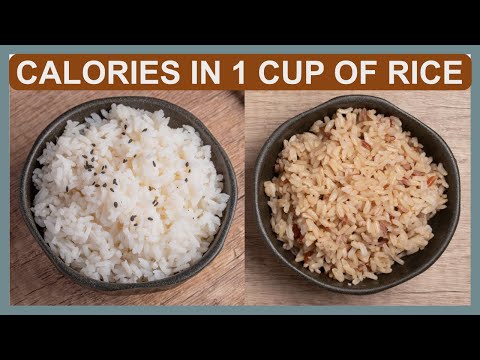Decoding Calories in Rice: What You Need to Know
When it comes to managing your diet, understanding the calorie content of different foods is essential. One staple that finds its place on countless dinner tables worldwide is rice. But have you ever wondered, “How many calories are there in rice?” In this comprehensive guide, we’ll delve into the calorie content of various rice varieties and explore the factors that can influence it. Whether you’re aiming for a calorie-conscious diet or simply curious about your food, this article will provide you with valuable insights.
Rice Varieties and Calorie Differences
Rice isn’t just rice; it comes in a variety of types and each has its unique characteristics, including calorie content. Let’s break down the differences:

how many calories are in rice
White Rice Calories:
White rice is a staple in many cuisines, known for its fluffy texture and mild flavor.
In a standard one-cup (195 grams) serving of cooked, long-grain white rice, you can expect around 205 calories.
Brown Rice Calories:
Brown rice is often hailed as the healthier option due to its higher fiber content and additional nutrients.
In the same one-cup serving size, brown rice contains approximately 216 calories, slightly more than white rice.
Jasmine Rice Calories:
Jasmine rice is praised for its fragrant aroma and slightly sticky texture.
A one-cup serving of cooked jasmine rice typically provides around 205 calories, similar to white rice.
Basmati Rice Calorie Content
Basmati Rice Calories:
Basmati rice, celebrated for its long, slender grains and aromatic flavor, is a favorite in Indian and Middle Eastern cuisines.
A one-cup serving of cooked basmati rice typically contains around 190 calories, making it a slightly lower-calorie option compared to white rice.
Cooking Methods and Calories
Now that we’ve explored the calorie content of different rice varieties, let’s delve into a critical aspect that can influence calorie count: cooking methods.
How Cooking Methods Affect Rice Calories:
The way you prepare rice can impact its calorie content. Boiling rice in water may cause it to absorb varying amounts of water, affecting the final calorie count.
If you’re looking to manage your calorie intake, consider measuring the rice and water precisely and following recommended cooking instructions.
Opt for cooking techniques like steaming or using a rice cooker to minimize calorie variations.
Rice in a Balanced Diet
Rice is a versatile and energy-rich food that can be a valuable part of a balanced diet. Here are some tips on how to incorporate rice sensibly into your daily meals:
Balanced Rice Consumption:
Portion Control: Be mindful of portion sizes to manage calorie intake effectively. Opt for smaller servings to complement your overall calorie goals.
Pair with Nutrient-Rich Foods: Combine rice with vegetables, lean proteins, and healthy fats for a well-rounded meal that offers a variety of nutrients.
Brown Rice for Added Nutrients: Consider incorporating brown rice for its higher fiber content and extra nutrients.
Calorie Comparisons with Other Grains
To better understand the calorie content of rice, it’s helpful to compare it with other grains commonly consumed in various diets:
Rice vs. Quinoa: A Calorie Comparison:
Quinoa, often considered a superfood, is known for its high protein and nutrient content.
In a one-cup serving, cooked quinoa typically provides around 222 calories, slightly more than white rice.
While quinoa offers more protein and some additional nutrients, rice remains a valuable source of energy.
Rice vs. Couscous: A Calorie Comparison:
Couscous, a staple in North African cuisine, has a different texture and flavor profile compared to rice.
A one-cup serving of cooked couscous contains approximately 176 calories, making it a lower-calorie option compared to both white and brown rice.
Couscous is a good choice for those seeking a lighter grain option.
Frequently Asked Questions to”how many calories in rice”:
Q: How many calories are in a cup of cooked white rice?
A: A cup of cooked white rice contains approximately 205 calories.
Q: Is brown rice higher in calories than white rice?
A: Yes, brown rice is slightly higher in calories compared to white rice. It contains about 216 calories per cup.
Q: How do the calories in jasmine rice compare to white rice?
A: Jasmine rice has a similar calorie count to white rice, with approximately 205 calories per cup.
Q: Is basmati rice lower in calories than other rice varieties?
A: Yes, basmati rice is slightly lower in calories compared to white rice. It contains around 190 calories per cup.
Q: Do cooking methods affect the calorie count of rice?
A: Yes, different cooking methods can influence the final calorie count of rice, though the variations are generally minimal.
Q: Can rinsing rice before cooking impact its calorie content?
A: Rinsing rice before cooking may remove some surface starch but has minimal impact on its calorie content.
Q: How does the calorie content of instant rice compare to regular rice?
A: Instant rice has a similar calorie count to regular rice once cooked, as it is typically precooked and dehydrated.
Q: Are there significant calorie differences between different brands of rice?
A: The calorie content of rice is generally consistent across brands, with minor variations based on type and serving size.
Q: Can I include rice in a weight loss plan without exceeding my calorie goals?
A: Yes, you can include rice in a weight loss plan by controlling portion sizes and balancing your overall calorie intake.
Q: How can I measure rice portions accurately to track calories?
A: To measure rice portions accurately, use a kitchen scale or measuring cup to ensure you stay within your desired calorie range.
Conclusion
In conclusion, understanding the calorie content of rice is essential for making informed dietary choices. While the calorie count varies among different rice varieties, cooking methods, and serving sizes, rice remains a versatile and valuable source of energy.




